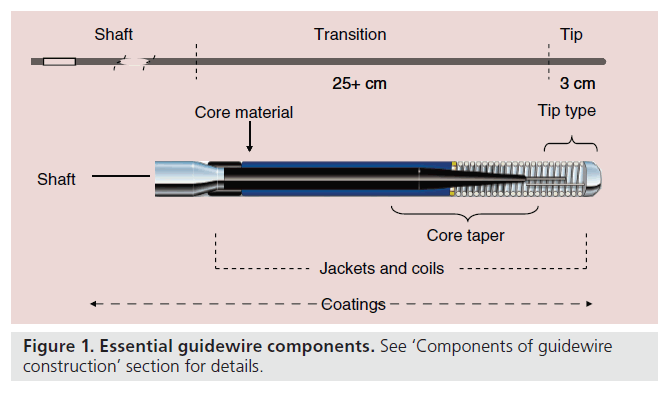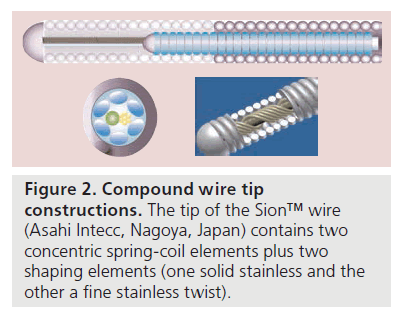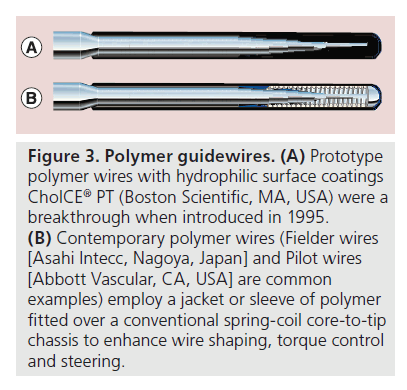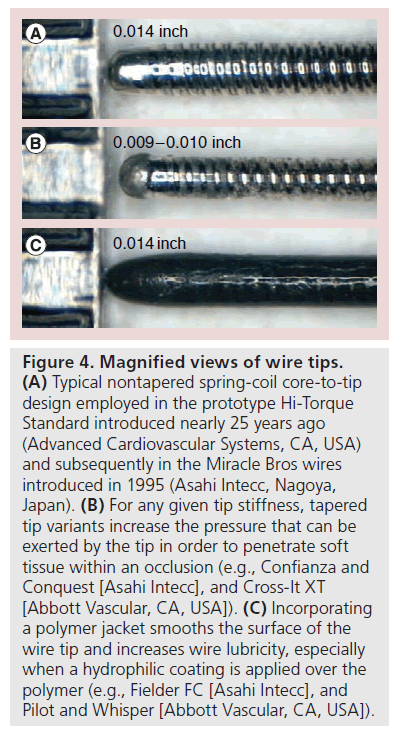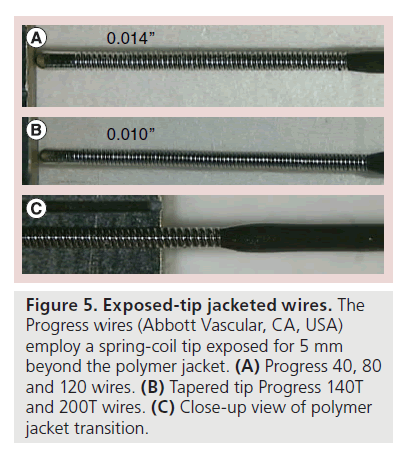Special Report - Interventional Cardiology (2013) Volume 5, Issue 5
Coronary guidewires for chronic total occlusion procedures: function and design
- Corresponding Author:
- Christopher E Buller
Cardiac Catheterization Laboratory
St Michaels Hospital, Toronto, ON
Canada and University of Toronto, ON, Canada
E-mail: bullerc@smh.ca
Abstract
Guidewires provide the primary interface between the hands of the percutaneous coronary intervention (PCI) operator and their therapeutic target, the coronary arteries. No other piece of PCI equipment directly influences the progress of a coronary procedure, modulates and addresses its specific technical challenges and contributes to the eventual success or failure of a procedure. For experienced operators, guide-wires become personal instruments that convey a specific feel and predictability of performance and engender strong preferences.
Keywords
chronic total occlusion, coronary collaterals, guidewire, percutaneous coronary intervention
Guidewires provide the primary interface between the hands of the percutaneous coronary intervention (PCI) operator and their therapeutic target, the coronary arteries. No other piece of PCI equipment directly influences the progress of a coronary procedure, modulates and addresses its specific technical challenges and contributes to the eventual success or failure of a procedure. For experienced operators, guide-wires become personal instruments that convey a specific feel and predictability of performance and engender strong preferences.
The complexity and variability of coronary guidewires has expanded greatly over three decades of competitive iteration and innovation. Design elements now include a wide array of primary, secondary and tertiary design elements. Manufacturers combine these elements in various ways to engineer wires with performance characteristics that target specific technical challenges. In parallel, PCI operators have discovered performance properties that were not intended by design, but which emerge as important in real-world use. This has proven to be especially true in the complex domain of PCI targeting chronic total occlusions (CTOs).
Components of guidewire construction
While not necessary for expert use, understanding basic guidewire construction provides insights that can aid operators to assemble a manageable range of wires in their laboratories, make rational wire choices for specific procedural needs, and create a framework for analyzing wirebased CTO failures. Coronary guidewires can be understood as an assembly of shaft, transition, tip, jacket and coating components (Figure 1).
▪ Shaft
The wire shaft constitutes the largest component of any coronary guidewire. Shafts are most commonly constructed of solid high-tensile stainless steel of circular cross-section and measuring slightly less than 0.014 inches in diameter. This dimension prevents binding within standard 0.014-inch catheter lumens, especially when lumens deform elliptically as catheters flex. Smaller diameter wire shafts are employed for specialty products such as Rotablator® guide-wires (Boston Scientific, MA, USA [101]), where overall device design forces engineers to restrict the wire lumen dimension. While wire shafts are arguably the least critical of the wire components, the marked reduction in kink resistance, torque transmission and column strength of 0.009-inch rotoblator guidewires serves to remind us of the key role the shaft plays in transmitting translational and rotational operator inputs and in overall wire utility. This is particularly true in monorail systems where the wire shaft is largely unsheathed and unsupported.
Advanced techniques used routinely in contemporary hybrid CTO procedures, particularly guidewire externalization, require extended length wires. Overall coronary guidewire length is determined almost exclusively by the length of the shaft component.
▪ Core
Bonded, welded or structurally continuous with the distal end of the shaft is the wire core. Cores are commonly 25–30 cm in length and machined from stainless steel or formed from super-elastic nitinol (a nickel–titanium alloy). Stainless cores are easy to weld and machine, tend to optimize torque transmission, and offer greater support for delivery of devices. Nitinol cores offer more flexibility and are remarkably kink resistant. While the core must transmit longitudinal and rotational forces from the shaft to the tip, it must also track and conform to the tortuosity inherent in guide catheter tips and arteries. To meet these competing demands, the core is designed to be modestly more flexible than the shaft through a reduction in its diameter or by the use of more flexible alloys.
In general, the core tapers toward the tip in order to increase flexibility in the distal wire segments, which must move easily through branch points and increasingly tortuous mid and distal coronary segments. This tapering is accomplished through machining (grinding). Step-wise tapering, while easy to manufacture, produces mechanical discontinuities that my lead to prolapse or kinking; conical and parabolic grinds have, therefore, been adopted in newer designs. An important inverse relationship exists between grinds that optimize flexibility versus support. Extra-support wires carry the full diameter of their stainless steel cores more distally compared with conventional wires.
▪ Tips
Wire tips, generally the distal 3 cm, are the most complex and variable assemblies in a coronary guidewire and play the largest role in determining the performance characteristics perceived by operators. First-generation steerable wires such as the aptly named prototype Hi-Torque Floppy™ (Advanced Cardiovascular Systems, CA, USA [102]) solved the dilemma posed by the competing need for steerability (stiffness in the rotational axis) with softness (flexibility in bending, or low tip loading in contemporary terms). By terminating the solid core several centimeters from the wire tip and replacing it with a thin, flat stainless steel shaping ribbon, a very soft and safe wire tip was created. At the same time, a platinum wire was wound in a tight helix to cover the shaping ribbon (spring-coil tip design). This provided rotational axis rigidity, dense radiopacity and a surface for bonding the tip components to each other and to the core without creating bending stiffness. Unexpectedly, the corrugated tip surface this design creates allowed operators to feel interactions between the wire and the endolumenal surface of the vessel. This phenomenon has been coined ‘tactile feedback’ and remains an important, if unintended, parameter for many operators. The friction produced by the corrugation also tends to stabilize wires in the distal coronary bed such that wires are less likely to inadvertently slip backwards or forwards (with risk of perforation).
The need for greater tip loads, as well as enhanced steering, has given rise to many guide-wires in which the core extends fully through the tip (core-to-tip design). Combined with a helical wind, this construction allows engineers to create tips with specific loads governed by the material and the grind profile of the core within the wire tip. Core-to-tip designs that combine a high tip load with a reduced tip diameter (i.e., 0.009 or 0.010 inches) create wires that generate higher tip pressure for any given tip stiffness. When pushed against soft tissue (as occurs when directed wiring is undertaken in chronic occlusions), this property improves the ability of the wire to pierce forward in a directed fashion. The capacity to create high tip pressures is often termed ‘penetrating power’.
Two novel approaches to core-to-tip design have emerged in recent years. The Kinetics design (Boston Scientific [101]) employes a micro-machined matrix as is used in some stent manufacturing processes. The geometry of the matrix is intended to optimize the balance between rotational and translational rigidity with a single element that can be made to vary over its length. Compound core designs have been introduced by in the Sion™ line of guidewires (Asahi Intecc, Nagoya, Japan [103]; Figure 2). Sion wires employ double spring coil winds over solid and twisted core elements to increase rotational rigidity while maintaining extremely low bend stiffness.
▪ Polymer
Many contemporary wires employ a polymer component. The prototype polymer wire is the ChoICE® PT (Boston Scientific [101]) in which a polymer element covers a tapered transitional core creating a true polymer-only wire tip. Limited tip shape retention and torque control of this early design has led to use of polymer jackets covering conventional transitional core and spring– tip designs (Figure 3). This construction can maintain the desirable mechanical properties of the underlying metallic wire. Generally a proprietary variant of polyurethane, polymer jackets provide a very smooth surface that, when coupled with hydrophilic coatings, markedly reduces friction between the wire and wet or water-containing surfaces and tissues. Abrasive surfaces (severe calcification at bends, stent struts, and in particular, high-pressure stent jailing of polymer jacketed wires) can score or even strip polymer, with obvious consequences with respect to wire performance and retained foreign material.
Figure 3. Polymer guidewires. (A) Prototype polymer wires with hydrophilic surface coatings ChoICE® PT (Boston Scientific, MA, USA) were a breakthrough when introduced in 1995. (B) Contemporary polymer wires (Fielder wires [Asahi Intecc, Nagoya, Japan] and Pilot wires [Abbott Vascular, CA, USA] are common examples) employ a jacket or sleeve of polymer fitted over a conventional spring-coil core-to-tip chassis to enhance wire shaping, torque control and steering.
▪ Hydrophilic or hydrophobic coating
Nearly all contemporary coronary guidewires have a thin hydrophilic or hydrophobic coating applied as the final manufacturing step. Some wires employ both but at different positions along the wire length. Hydrophilic coatings (e.g., polyethylene oxide or polyvinyl pyrolidone) require water activation to become slippery, but once wet have extremely low coefficients of friction. When used inside very tight-fitting catheters, the boundary layer of water can be excluded, leading to paradoxic sticking and locking. Hydrophobic coatings (i.e., polytetrafluoroethylene or silicones) are inherently slippery and do not require water for activation. Silicone or its variants are commonly applied to wire shafts to improve movement through plastic catheters. Both hydrophilic and hydrophobic coatings may chafe or degrade with use. This can account for the degradation in wire performance sometimes noted during long procedures, particularly when wires are working through areas of severe tortuosity and friction.
Guidewire tasks demanded by hybrid CTO procedures
Just as the hybrid approach to CTO procedures has created discrete skill sets (e.g., collateral crossing, subintimal tracking, re-entry, reverse controlled antegrade and retrograde tracking (CART) and externalization, among others) an analogous framework for matching coronary guidewires to specific operations during complex hybrid CTO procedures can be created. This approach moves the discussion past the traditional orientation of ‘CTO wires’ and into the realm of task-specific wire selection wherein a diverse range of guidewires will be exploited during a single procedure in order to efficiently complete each planned step as well as overcome unexpected technical barriers.
▪ Access
Complex CTO procedures require management of accumulating radiation dose from the outset. Tasks such as accessing the proximal cap, the inlet to a collateral, or small anchor branches and protecting major side branches should be undertaken with maximum efficiency using a high-performance access guidewire shaped by the operator – not the factory – with an appropriate tip length and angle, radius of curvature or compound shape to suit the specific anatomy in hand. Intimate familiarity with the wire is paramount if rapid assessment and analysis of steering challenges with reactive adjustments to tip shape are to occur. To this end, a CTO operator’s access wire should be the same wire routinely used by that operator during non-CTO PCI (or vice versa).
Most CTO operators value rapid, precise tip shaping over tip shape retention, and hence prefer access wires with stainless steel shaping rib-bons or tip cores rather than nitinol tip cores. Long (300 cm) versions of access wires should be avoided; the excess shaft reduces tip control, and long wires obscure the external visual cue (i.e., not requiring fluoroscopy) that the tip is approaching the end of the guide or microcatheter. The access wire should be safe with its nonjacketed, very soft or prolapsed spring-coil tip left ‘unattended’ in small distal branches, and should be suitable for jailing behind stents. A wire that is extendable (dockable) to 300 cm can prove useful.
Popular access wires are the Prowater (Asahi Intecc [103]), Wizdom (Boston Scientific [101]) and Advance (Abbott Vascular, CA, USA [104]) all with stainless steel core-to-tip design, the BMW and BMW Universal II (Abbott Vascular [104]) with nitinol transition cores and stainless steel shaping ribbons, and the Runthrough™ NS (Terumo Corporation, Tokyo, Japan [105]) and BMW Elite (Abbott Vascular [104]) with nitinol core-to-tip design.
▪ Collateral crossing
Collaterals combine tortuosity with small diameter, and the interplay of these two variables informs initial wire choice. Tortuosity demands low tip loads, and small diameter favors wire lubricity.
Septal or epicardial collaterals with mild-to-moderate tortuosity that are visible as relatively large through-and-through connections are naturally the least demanding, and can occasionally be crossed with an access wire. As the collateral becomes smaller, a premium on wire lubricity emerges. Tiny trans-septal or epicardial collaterals that are at, or below, the threshold for angiographic visibility favor soft, very lubricious polymer-jacketed wires such as the Pilot 50 (Abbott Vascular [104]) or Fielder FC (Asahi Intecc [103]). Avoiding a wedge position with the supporting microcatheter, thereby maintaining flow in the collateral, optimizes hydrophilic coating activation. Tiny or invisible collaterals may tempt use of tapered-tip polymer jacketed wires such as the Fielder XT (Asahi Intecc [103]). However, experience has shown that delicate collaterals both in the septum and epicardium are easily perforated by such wires presumably consequent to the higher tip pressures exerted (see the ‘Tips’ section).
When severe tortuosity is observed or suspected, a wire with the lowest possible tip loads that can conform to very small radius bends trumps wires with ultimate lubricity. Presently the Sion wires enjoy a unique role in severely tortuous collaterals [103]. When tortuosity is extreme, the Sion wire can be given a small preformed prolapse shaped tip (‘umbrella handle’) that bluntly seeks the lumen. Compared to the Pilot 50 and Fielder FC, the extremely flexible Sion has a correspondingly less supportive transitional core. This can compromise delivery of the microcatheter through the collateral despite successful collateral wiring.
In general, wire steering is not an important performance criterion for collateral crossing. However, some collaterals do contain critical branch points at which one of the limbs must be deliberately selected. At such points, wire steering becomes temporarily important and soft polymer-jacketed wires may be inadequate. Sion wires, a high-performance access wire (see the ‘Access’ section), or a stiffer-tipped polymer-jacketed wire (Pilot 100, 150 or 200) with a customized tip shape can overcome this challenge. Transition back to a collateral crossing wire should occur once the microcatheter is advanced past the branch point.
Whereas the nonconcentric compound tip design employed in the Sion wires provides a unique combination of torque control and longitudinal flexibility, newer concentric compound tapered-tip designs such as those embodied in the Asahi Intecc Gaia® wire family may advance the performance of tapered wires further.
▪ Directed penetration
Directed penetration is the wire function that is associated with traditional antegrade CTO PCI wherein one or more wires are used to penetrate the proximal cap and gradually steer through the occluded segment to the distal true lumen (i.e., the strategy of ‘true-to-true’ wiring, and historically including ‘parallel’ or ‘see-saw’ wiring techniques). In hybrid CTO work, directed penetration may also be performed retrogradely though an occlusion, in the subintimal space to redirect blunt dissection at branch points, or away from the lumen into the subintimal space to bypass impenetrable calcification.
Directed penetration is optimized by wires with high tip loads and optimized torque transmission that can be reliably shaped with durable, short (1–3 mm), angulated tips. The prototypes for this genre of wire were the Hi-Torque Intermediate® and Standard® wires (Advanced Cardiovascular Systems [102]) developed in the 1980s. These have since been eclipsed by Miracle Bros 3 through 12 wires (Asahi Intecc [103]) and Progress® 40, 80 and 120 wires (Abbott Vascular [104]) (Figures 4& 5). These wires all share stainless steel core-to-tip design and are nontapered (i.e., approximately 0.014-inch diameter throughout). The Progress family includes a polymer jacket that ends 5 mm from the wire tip. This design is intended to reduce friction and tactile feedback arising from points other than the wire tip, and to enhance wire passage through sclerotic occlusive tissue.
Figure 4. Magnified views of wire tips. (A) Typical nontapered spring-coil core-to-tip design employed in the prototype Hi-Torque Standard introduced nearly 25 years ago (Advanced Cardiovascular Systems, CA, USA) and subsequently in the Miracle Bros wires introduced in 1995 (Asahi Intecc, Nagoya, Japan). (B) For any given tip stiffness, tapered tip variants increase the pressure that can be exerted by the tip in order to penetrate soft tissue within an occlusion (e.g., Confianza and Conquest [Asahi Intecc], and Cross-It XT [Abbott Vascular, CA, USA]). (C) Incorporating a polymer jacket smooths the surface of the wire tip and increases wire lubricity, especially when a hydrophilic coating is applied over the polymer (e.g., Fielder FC [Asahi Intecc], and Pilot and Whisper [Abbott Vascular, CA, USA]).
Tapered-tip designs offer higher tip penetrating pressure at any given value of bending stiffness (tip load). Cross-It XT 100–400 (Abbott Vascular [104]), Progress 140T and 200T wires, and the Conquest Pro and Confianza Pro (Asahi Intecc [103]) wires are examples (Figures 4 & 5).
Wire families with various tip loads, as described above, were developed in an era before contemporary hybrid techniques. Fear of entering the subintimal space or of perforating the coronary entirely, created demand for wires with progressive tip loads employed cautiously and sequentially in a strategy of ‘wire escalation’. Hybrid techniques de-emphasize wire escalation owing to the development of re-entry strategies, and the understanding that vessel perforation is rarely dangerous or procedure-stopping providing that it is recognized before larger diameter devices are delivered over the errant wire beyond the outer boundary of the coronary artery architecture. Most experienced CTO operators limit them-selves and their overburdened inventory to two or three wires optimized for directed penetration, one of which is usually the Confianza Pro-12. Progress 120, Miracle Bros 12 and Progress 200T are the common alternatives. Conquest wires are identical in construction to Confianza wires of the same tip load, but lack the hydrophilic tip coating. In some jurisdictions the Confianza Pro 8–20 is available. This wire approaches twice the bend stiffness of the Pro-12. The Pilot 200 [104], a stiff polymer-jacketed wire is often used for directed penetration in short occluded segments (<1 cm). Its capacity to inadvertently penetrate through the vessel wall when used in conventional configuration (without a knuckle, see the ‘Knuck-ling’ section) makes it poorly suited for directed penetration over long segments.
▪ Traversing microchannels
Microchannels within occluded segments share many characteristics with small, tortuous collaterals, but unlike collaterals, are contained within plaques, making them stiffer and less prone to rupture. Here, tapered-tip polymer jacketed wires, such as the Fielder XT [103], that will slide through the microchannel undirected by the operator are usually the wires of first choice. When progress is prevented due to wire buck-ling, nontapered polymer jacketed wires or Sion wires are rational second-line choices. Like the Sion, the Fielder XT provides poor support for delivery of catheters through the occlusion after otherwise successful wiring.
▪ Knuckling
Knuckling refers to the intentional forceful advancement of a prolapsed wire, usually in subintimal arterial tissue, to create a plane or space through blunt dissection. While any wire can be made to prolapse and knuckle, the slippery surface of polymer-jacketed wires greatly improves their capacity to bluntly dissect vascular tissue planes at forces that can easily be transmitted during PCI. The diameter of the knuckle (and thus the lateral extent of the dissection plane) is ultimately limited by the elastic limits of the adventitia. Knuckle dimensions are larger when wires with high tip loads (such as the Pilot 200) are used compared with wires with lower tip loads (Pilot 50, or even Fielder XT). The column strength of transitional cores is significantly lower in low tip-load wires; advancing a knuckle on low tip-load wires often requires the micro-catheter to be brought into proximity with the knuckle in order to reinforce column strength.
On a practical note, polymer-jacketed wires with tips that have been over-bent during collateral crossing or other maneuvers can be saved for use as knuckle wires later in the procedure, since blunt dissection with knuckling is enabled by such bends.
▪ Re-entry
Re-entry, the advancement of a guidewire from the subintimal planes to the true lumen, occurs in several distinct scenarios during hybrid CTO procedures. In limited antegrade subintimal tracking maneuvers, or failed true-to-true wiring attempts in which the guidewire passes beyond the distal cap but lies within the subintimal space, directed penetration can sometimes achieve re-entry. The wire characteristics and tip shapes are generally not different from those used in other forms of directed penetration (see the ‘Directed penetration’ section). A barbed Stingray™ wire (Boston Scientific [101]) can be employed for re-entry through a conventional microcatheter if the relationship between the false plane and true lumen is clearly visualized and thin (<2 mm).
Re-entry may also occur when an unseen communication between the subintimal space and the true lumen has been created by dissection (usually reverse CART) or Stingray-facilitated re-entry (Stingray catheter and guidewire). Polymer-jacketed wires that can be directed to a moderate degree, however, seek a path of low resistance through pinholes (i.e., stick-and-swap maneuvers via Stingray catheters) or disrupted tissues (after reverse CART or other longitudinal dissection maneuvers) are most efficient in this role (Pilot 50 through 200). When re-entering retrogradely after reverse CART, the a priori use of a 300-cm length re-entry wire allows the operator to proceed to externalization with a single wire. The Pilot 200 is frequently used in this fashion. Re-entry after reverse CART occasionally requires highly directed steering, perhaps because the reconnection is marginal or incomplete leaving a thin tissue plane to be penetrated. When polymer jacketed wires fail to achieve re-entry despite aggressively sized reverse CART ballooning, wires optimized for directed penetration may succeed.
▪ Externalization
Externalization following retrograde wiring of a CTO requires extended-length wires that can span the length of two-guide catheter systems, the external portion of a trans-collateral microcatheter (usually Corsair®, Asahi Intecc [103]) plus the relevant coronary or bypass graft anatomy. At least several centimeters of extra wire are needed beyond either end of the catheters to mount devices and maintain wire tension control.
Wires that are 300 cm in length are marginally suitable for this role, and require at least one guide catheter to be short (~90 cm instead of the standard 100 cm site). A broad range of wires are available in 300 cm lengths, with Pilot 200 wires being widely preferred for this function due to the lubricous jacket that eases externalization and the relatively stiff tip, which eases loading of balloon catheters and stent-delivery systems.
The 330-cm Rotoblator wires have been used successfully but their fragility makes them difficult to work with and prone to kinking. The Viperwire™ (a component of Orbital Atherectomy systems, Cardiovascular Systems Inc., MN, USA [106]) is a very stiff 330-cm wire intended for use in the peripheral arterial system that has nevertheless been used for transcollateral externalization. Its stiffness makes it poorly suited to traversing coronary tortuosity even when sheathed in a microcatheter. More recently, the RG3 (Asahi Intecc) and R350™ (Vascular Solutions, MN, USA [107]) medium stiffness stainless steel wires of 330 and 350 cm, respectively have been developed with CTO externalization in mind. The RG3 includes a hydrophilic coating over its full length. Wire lengths of 330 cm or greater obviate the need for short guide catheters, at least with respect to wire externalization.
Snaring is a useful maneuver to enable externalization if direct retrograde entry into the antegrade guide catheter or guide extender does not occur. Snaring should occur in a segment of the wire that contains a core element. Snaring of wire tips constructed with shaping ribbons can lead to unwinding of spring-coils or tensile wire fracture. The Pilot 200, RG3 and R350 wires are of core-to-tip design and are well suited to snaring.
Conclusion
Contemporary coronary guidewires have evolved with diverse construction providing a range of mechanical characteristics and various other properties. In hybrid CTO procedures, a rational approach to wire selection involves a basic understanding of wire design and construction parameters. Task-specific use of wires through the course of a complex CTO procedure allows efficient use of time and radiation, and understanding the mechanics of each task is central to matching specific wires to specific tasks. The same under-standing of coronary guidewires enables operators to build an efficient selected wire inventory that is easily managed.
Financial & competing interests disclosure
CE Buller receives honoraria and consulting fees from Boston Scientific, Abbott Vascular and Volcano Corporation in relation to guidewire design and treatment of chronic total occlusions. The author has no other relevant affiliations or financial involvement with any organization or entity with a financial interest in or financial conflict with the subject matter or materials discussed in the manuscript apart from those disclosed.
No writing assistance was utilized in the production of this manuscript.
Executive summary
Background
▪ Guidewires are centrally important to the success of complex percutaneous coronary intervention, especially chronic total occlusion (CTO) percutaneous coronary intervention.
▪ Guidewire design and materials use have advanced greatly over three decades of competitive innovation.
Components of guidewire construction
▪ Guidewires are an assembly of shaft, core (transition), tip, jacket and coating components.
▪ Shafts are generally made from stainless steel.
▪ Shaft diameter markedly influences transmission of torque and translation inputs from operator to wire tip.
▪ The core component (also referred to as the transition) is a machined, tapered component (or extension of the shaft) that serves to reduce wire stiffness gradually towards the tip.
▪ Cores may be stainless or Nitinol.
▪ Tips are highly variable in design, but frequently employ a helical platinum wire winding as an outer structural element (spring coil).
▪ The core may end proximal to the tip, maximizing tip flexibility, or extend to the tip to augment torque transmission or to increase tip bending stiffness (tip load).
▪ Compound multi-element tip designs have recently been introduced.
▪ Polymer jackets (often polyurethane) are employed to smooth the wire surface.
▪ Coatings, both hydrophilic and hydrophobic, are used as surface lubricants.
Guidewire tasks
▪ Guidewires are required to perform specific tasks during CTO procedures, including lesion access, directed penetration, collateral crossing, traversing microchannels, subintimal tracking, re-entry and externalization.
▪ Guidewire design, in which components with specific characteristics are combined, creates wires that are optimized for one or more of these tasks.
▪ Lesion access demands tip safety and steerability in a nonocclusive (unconstrained) environment and adequate support for device delivery.
▪ Collateral crossing generally demands longitudinal flexibility be combined with moderate rotational stiffness (torque control) and a lubricious surface.
▪ Directed penetration demands greater stiffness in longitudinal and rotational (torque) axes to permit the wire to be advanced and controlled in a constrained environment (within the CTO tissue).
▪ Traversing microchannels demands characteristics similar to collateral crossing but with tapered tip designs favored by many operators.
▪ Knuckling requires that a wire be sufficiently lubricious to move through the subintimal space and have sufficient core stiffness to translate longitudinal forces without buckling or kinking.
▪ Re-entry is a subset of directed penetration tasks.
▪ Sharp-tipped Stingray™ wire (Boston Scientific, MA, USA) has been developed specifically for re-rentry when used in combination with a specific orientation device (Stingray balloon).
▪ Externalization is benefited by dedicated wires with extraordinary length and that are sufficiently flexible in their shafts to prevent cardiac trauma.
Summary
▪ Task-specific use of wires through the course of a complex CTO procedure allows efficient use of time and radiation.
▪ Understanding coronary guidewires enables operators to build an efficient selected wire inventory that is easily managed.
Websites
- Boston Scientific.
- Advanced Cardiovascular Solutions. www.acvs.in
- Asahi Intecc. www.asahi-intecc.com/index.php
- Abbotts Vascular. www.abbottvascular.com/us/index.html
- Terumo Corporation. www.terumo.com
- Cardiovascular Systems Inc. www.csi360.com
- Vascular Solutions. http://vasc.com
